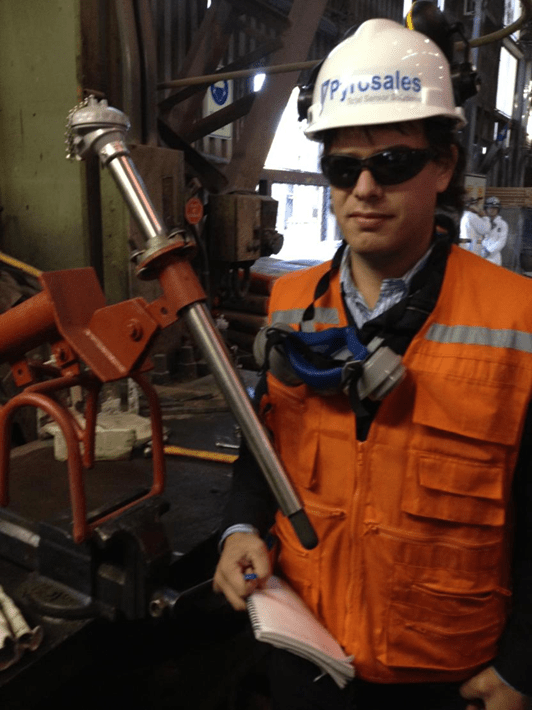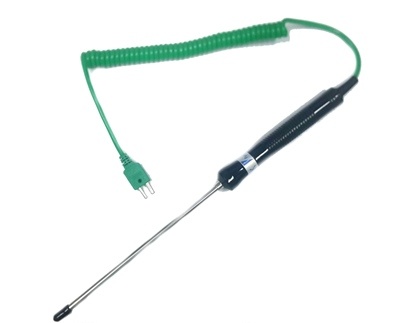1300 737 976
Call us
Live Chat
Call us

A Thermocouple is a sensor used to measure temperature. Thermocouples consist of two wire legs made from different metals. The wire’s legs are welded together at one end, creating a junction. This junction is where the temperature is measured. When the junction experiences a change in temperature, a voltage is created. The voltage can then be interpreted by calculating the temperature.
A popular notion is that the EMF (Electric and Magnetic Fields) is generated at the tip or hot end of the thermocouple at the junction between the two metals. This notion is completely incorrect. The EFM is not localised to the tip but is dispersed throughout the lengths of each leg. The total EMF generated in a thermocouple is the difference between the EMF’s in both legs. This is due to the Seebeck coefficient of the metal or alloy used. (Seebeck Effect is a phenomenon in which a temperature difference between two dissimilar electrical conductors or semiconductors produces a voltage difference between the two substances. This can be applied to thermal-to-electrical energy conversion. The Seebeck effect was discovered in 1821 by Thomas Seebeck). This coefficient is a measure of how the electrons are coupled to the environment, to the metal lattice, and, on a larger scale, to the grain structure.
It is sensitive to changes in the chemical and physical features of the metal and will change if the metal is contaminated, oxidised, strained or heat treated. Since all those processes depend on temperature and a thermocouple, because of its usage, experiences non-uniform temperature fields, there will be non-uniform changes in the Seebeck coefficient and therefore the thermocouple output. The wires thereby acquire a thermoelectric imprint or “signature”. Any change in the environment will affect the thermocouple output. A typical change is immersion depth. A change in thermocouple output resulting from reducing the immersion depth could be considerable. For example, a 24 AWG nickel-based thermocouple would only drift about 1oC in 16 hours, while monitoring a temperature of 1000oC, yet, if its immersion depth is decreased the output could change a further 15oC. Therefore, it is advisable to have thermocouples installed in a fixed position.
What are the different types of Thermocouples?
There are many types of thermocouples, each with different characteristics in terms of temperature range, durability, vibration resistance, chemical resistance, and application compatibility. Type J K, T “Base Metal” thermocouples, the most common types of thermocouples. Type R and S thermocouples are “Rare Metal” thermocouples, which are used in high-temperature applications.
Where are Thermocouples used?
Thermocouples are used in many industrial, scientific, applications. They can be found in nearly all industrial markets: Power Generation, Mining, Oil/Gas, Pharmaceutical, BioTech, Cement, Paper, Glass, and many more. Thermocouples are also used in everyday appliances like stoves, furnaces, kilns, and pizza ovens.
Why use a Thermocouple?
Thermocouples are used in many industrial, scientific, applications. They can be found in nearly all industrial markets: Power Generation, Mining, Oil/Gas, Pharmaceutical, BioTech, Cement, Paper, Glass, and many more. Thermocouples are also used in everyday appliances like stoves, furnaces, kilns, and pizza ovens.
Why use a Thermocouple?
Thermocouples are typically selected because of their low cost, high-temperature limits, wide temperature ranges, and durable nature.
Summary of Thermocouple Applications
Each type of thermocouple is chosen based on specific temperature ranges, stability, and application requirements.
General Limitations of Thermocouples:
The choice of a thermocouple must consider these limitations to ensure it aligns with the specific demands of the application. For example, certain types of thermocouples are not cost effective for general purpose use or at certain temperatures.
The history of the thermocouple
Back in 1821, German physicist Thomas Johann Seebeck explored the notion of different metals when they are joined together. He discovered that temperature changes between the joints and a magnetic field were observed – this is known as the Seeback effect.
From there, the magnetic field was later discovered to be part of the thermoelectric current. The voltage generated from the two types of wire is what is used to measure temperature from very high to low.
The threshold of the temperature measurement depends on the type of wire material used, and although at a very low current, power can be generated from a thermocouple junction.
Scientists Michael Faraday and Georg Ohm used the Seeback effect to conduct experiments to help further understand the impact and temperature measurement.
From this discovery, and after further research from scientists throughout history, thermocouples were manufactured in the early 1900s. Since then the technology has developed and advanced to what it is today. They are now used in many different appliances from food preparation to pharmaceutical manufacturing.

Since the discovery of temperature measurement, the manufacturing of the device has continued to be simple but effective. The two metal alloys come together to form a junction.
One part of the junction is placed on the source where the temperature needs to be measured. The second point of the junction is maintained at the constant temperature source.
The temperature range is dependent on the type of metal used in the manufacturing of the thermocouple. Nickel and nickel have a temperature range of -50 to 1,410, while rhenium and rhenium measures from 0 to 2,315 degrees.
The construction of a thermocouple is simple, and manufacturers assemble the temperature gauges from the pair of wires. A protective layer of insulated tubing usually covers these wires.
Manufacturers of thermocouples decide the combination of metals and calibration used to assemble. The use of the thermocouple is dependant on the environment. The different diameters and materials are all factors considered when manufacturing the specific type of thermocouple.
In other cases, the installation of a thermocouple to a pre-existing system can alter how the manufacturer designs the device.
Types of thermocouples
Various thermocouples are manufactured for different purposes, using a variety of metals.
At the core of a thermocouple’s operation is a physical principle known as the Seebeck Effect, which allows it to convert heat energy into an electrical signal.
The operation of a thermocouple is based on the Seebeck Effect, a principle discovered by physicist Thomas Seebeck in 1821. Here’s a step-by-step explanation of how thermocouples work:
Thermocouples are widely used temperature sensors made from different metals designed for specific applications. They are valued for their durability, accuracy, and broad operating temperature ranges. Different types of thermocouples are designated by letter codes (e.g., K, J, T) and are constructed using specific combinations of metal alloys. Each type is suited for specific applications based on factors such as temperature range, accuracy, stability, and cost.
Below is an expanded overview of the most popular thermocouple types and their unique characteristics:
Each type of thermocouple is optimised for specific conditions, balancing factors such as temperature range, sensitivity, accuracy, and cost. The selection of the appropriate thermocouple depends on the application’s unique requirements, such as the operating environment, desired precision, and budget constraints. Understanding these types helps engineers and technicians achieve reliable and efficient temperature measurements in a wide variety of fields.

Industrial thermocouples are a popular type. Manufacturers offer these thermocouples on a range from “IS A – M”. General-purpose thermocouples are suited for most applications and come at a low cost. The most commonly manufactured general-purpose thermocouple is Type K.
Lastly, multipoint thermocouples are the most accurate form of temperature measurement. They are used where the correct measurement and management of temperature is critical. These are manufactured as types E, K, J, N, and T, which are made from different materials.
Final thoughts on manufacturing a Thermocouple
The manufacturing of a thermocouple ranges and is dependent on the different needs of temperature measurement. From low to high, there is a variation of metals and materials used to form the right type of thermocouple for any maintenance of temperature.
When it comes to choosing the right one, it is all about the research and your manufacturer’s knowledge. That’s why Pyrosales offers expert advice to recommend the right thermocouple for your application. The correct temperature of any element is crucial for the manufacturing of all temperature related products.
Copyright © 2022 Created by Pepper Digital
Disclaimer – Images for illustrative purposes only and may not be representative of the actual resolution of the camera shown.